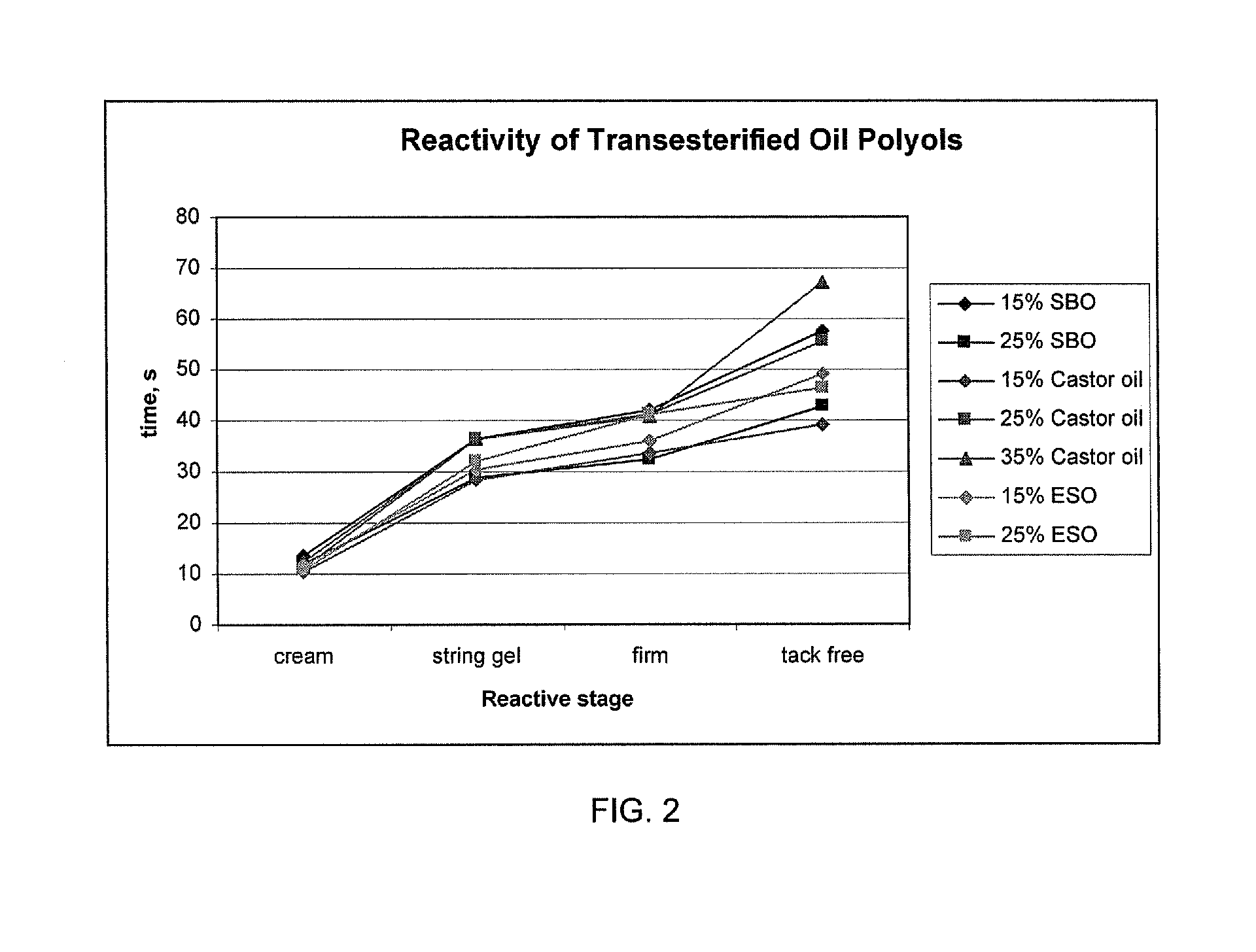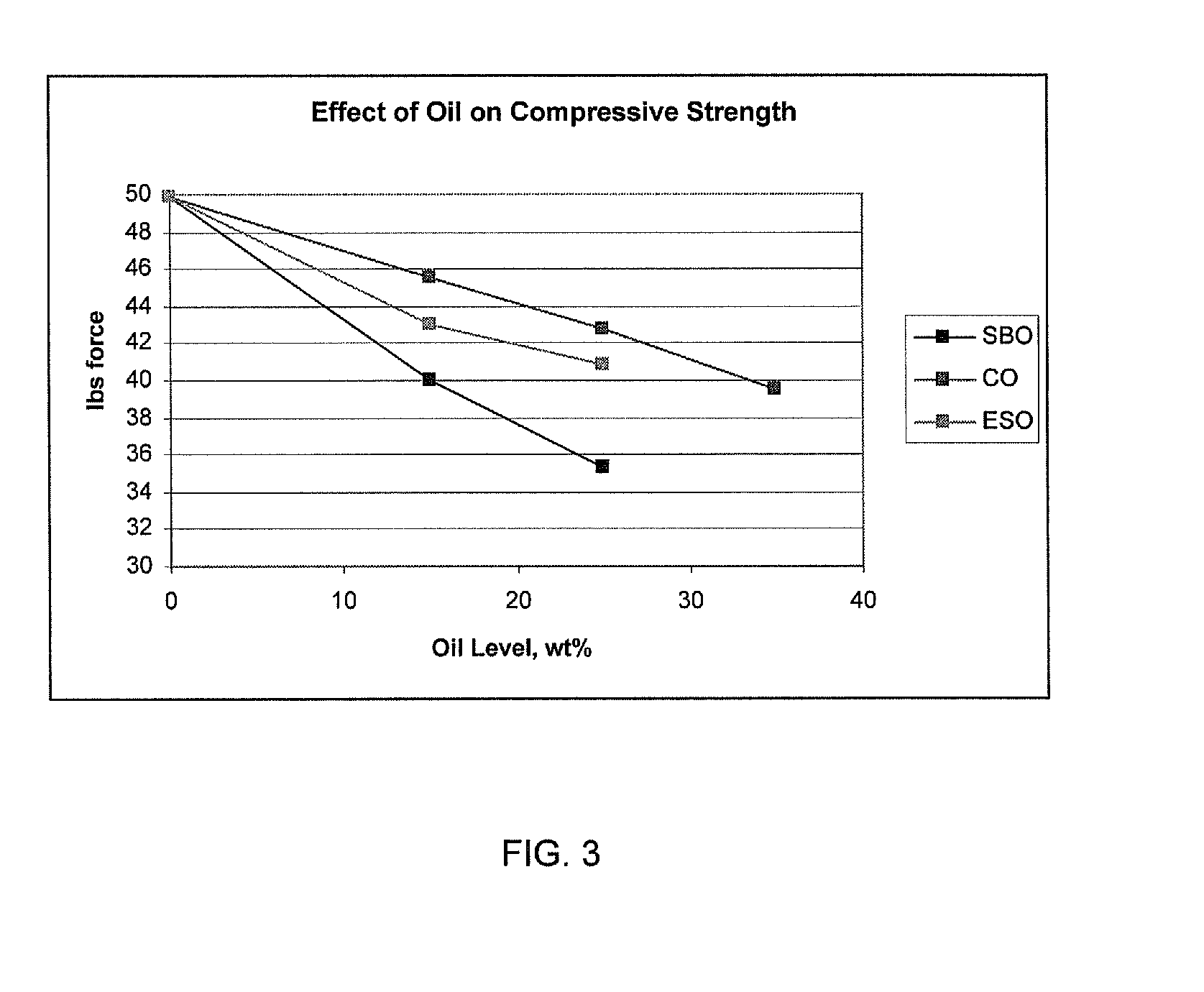Aromatic Polyester Polyols and Aromatic Polyester Polyol Blends Containing Biorenewable Components and Methods of Making
a technology of aromatic polyester and polyester polyol, which is applied in the field of aromatic polyester polyol blends containing biorenewable components and making methods, can solve the problems of deterioration of foam properties, and use of natural oils
- Summary
- Abstract
- Description
- Claims
- Application Information
AI Technical Summary
Benefits of technology
Problems solved by technology
Method used
Image
Examples
example 1
Phase Stable Polyol Blends
[0141]Mixtures of phthalic acid based polyester polyols and renewable polyols (natural oil) were prepared by combining the two materials in a scintillation vial in the ratios noted in Table 1 below. The aromatic polyol was added first and the renewable polyol was added second. The scintillation vial was then heated to 60° C. and the materials were mixed well by hand stirring. The initial appearance of each of the mixtures was noted. The mixtures were then allowed to cool overnight and then the compatibility of each of the mixtures was noted. The results for each of the mixtures are reported in Table 1.
TABLE 1Aromatic% TransesterifiedRenewableWt. %RunPolyesterOil in AromaticPolyolRenewableAppearanceAppearanceNo.PolyolPolyester PolyolAddedPolyolAfter mixingAfter 1 dayCompatibility1PA polyol 18castor oil25cloudyseparatedseparates2PA polyol 410castor oil25cloudyseparatedseparates3PA polyol 730castor oil25cloudyseparatedseparates4PA polyol 650castor oil25cloudy...
example 2
Use of Nonionic Surfactants and Transesterified Natural Oil in Phase Stable Polyol Blends
[0143]In this example, mixtures of aromatic polyester polyols and renewable polyols were evaluated with and without added nonionic surfactants for compatibility. The types and amounts of polyols comprising each mixture and the compatibility results are reported in Table 2.
TABLE 2Max %AromaticRenewableRenewableRunPolyesterCompatibi-PolyolPolyolNo.Polyollizer(s)*AddedCompatible**1STEPANPOLnonecastor oilPS-240221929-95A18%castor oil4reacted SBO31929-95A15.3%castor oil6reacted SBO,15% Toximul82404STEPANPOLnoneVikol 1PS-240251929-95A18%Vikol 15reacted SBO61929-95A15.3%Vikol 18reacted SBO,15% Toximul8240*Percentages based on final composition, aromatic polyester polyol with compatibilizers, before renewable polyol addition.**“Compatible” means clear or slightly hazy, no separation of phases. Above this level, mixture becomes very hazy, and separates on standing. Percentages based on total blend, aro...
example 3
Nonionic Surfactant as Sole Compatiblizer for Phase Stable Polyol Blends
[0145]In this example, a nonionic surfactant is used as the only compatibilizer for the mixtures of aromatic polyester polyols and renewable polyols. In other words, the aromatic polyester polyol contained no transesterified triglyceride oil. The polyols and nonionic surfactants used for each mixture and the compatibility results obtained are reported in Table 3.
TABLE 3Max %RenewablePolyolAromaticRenewableCompatiblePolyesterCompatibi-Polyol(1 hour, roomNo.PolyollizerAddedtemperature)1STEPANPOLNoneESO Polyol 11PS-24022STEPANPOL14% ToximulESO Polyol 16PS-240282403STEPANPOL13%ESO Polyol 115PS-2402Surfactant 2Percentages based on total blend, aromatic polyester polyol + compatibilizer + renewable polyol.“Compatible” means clear or slightly hazy, no separation of phases.
[0146]The results in Table 3 demonstrate that a nonionic surfactant can effectively compatibilize a renewable polyol.
PUM
| Property | Measurement | Unit |
|---|---|---|
| temperature | aaaaa | aaaaa |
| viscosity | aaaaa | aaaaa |
| aromatic | aaaaa | aaaaa |
Abstract
Description
Claims
Application Information
 Login to View More
Login to View More - R&D
- Intellectual Property
- Life Sciences
- Materials
- Tech Scout
- Unparalleled Data Quality
- Higher Quality Content
- 60% Fewer Hallucinations
Browse by: Latest US Patents, China's latest patents, Technical Efficacy Thesaurus, Application Domain, Technology Topic, Popular Technical Reports.
© 2025 PatSnap. All rights reserved.Legal|Privacy policy|Modern Slavery Act Transparency Statement|Sitemap|About US| Contact US: help@patsnap.com



